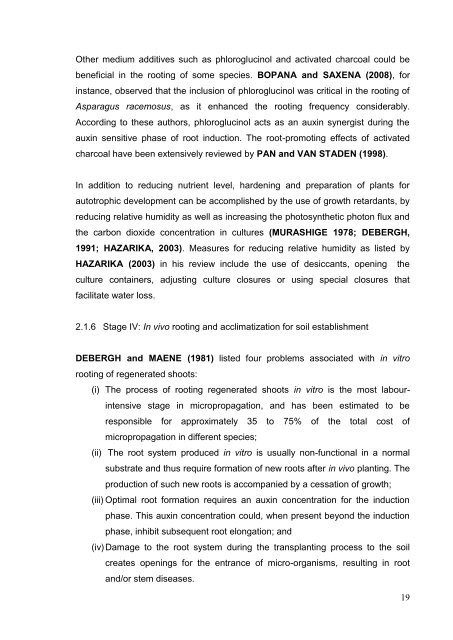Micropropagation and medicinal properties of Barleria greenii
Micropropagation and medicinal properties of Barleria greenii
Micropropagation and medicinal properties of Barleria greenii
Create successful ePaper yourself
Turn your PDF publications into a flip-book with our unique Google optimized e-Paper software.
Other medium additives such as phloroglucinol <strong>and</strong> activated charcoal could be<br />
beneficial in the rooting <strong>of</strong> some species. BOPANA <strong>and</strong> SAXENA (2008), for<br />
instance, observed that the inclusion <strong>of</strong> phloroglucinol was critical in the rooting <strong>of</strong><br />
Asparagus racemosus, as it enhanced the rooting frequency considerably.<br />
According to these authors, phloroglucinol acts as an auxin synergist during the<br />
auxin sensitive phase <strong>of</strong> root induction. The root-promoting effects <strong>of</strong> activated<br />
charcoal have been extensively reviewed by PAN <strong>and</strong> VAN STADEN (1998).<br />
In addition to reducing nutrient level, hardening <strong>and</strong> preparation <strong>of</strong> plants for<br />
autotrophic development can be accomplished by the use <strong>of</strong> growth retardants, by<br />
reducing relative humidity as well as increasing the photosynthetic photon flux <strong>and</strong><br />
the carbon dioxide concentration in cultures (MURASHIGE 1978; DEBERGH,<br />
1991; HAZARIKA, 2003). Measures for reducing relative humidity as listed by<br />
HAZARIKA (2003) in his review include the use <strong>of</strong> desiccants, opening the<br />
culture containers, adjusting culture closures or using special closures that<br />
facilitate water loss.<br />
2.1.6 Stage IV: In vivo rooting <strong>and</strong> acclimatization for soil establishment<br />
DEBERGH <strong>and</strong> MAENE (1981) listed four problems associated with in vitro<br />
rooting <strong>of</strong> regenerated shoots:<br />
(i) The process <strong>of</strong> rooting regenerated shoots in vitro is the most labour-<br />
intensive stage in micropropagation, <strong>and</strong> has been estimated to be<br />
responsible for approximately 35 to 75% <strong>of</strong> the total cost <strong>of</strong><br />
micropropagation in different species;<br />
(ii) The root system produced in vitro is usually non-functional in a normal<br />
substrate <strong>and</strong> thus require formation <strong>of</strong> new roots after in vivo planting. The<br />
production <strong>of</strong> such new roots is accompanied by a cessation <strong>of</strong> growth;<br />
(iii) Optimal root formation requires an auxin concentration for the induction<br />
phase. This auxin concentration could, when present beyond the induction<br />
phase, inhibit subsequent root elongation; <strong>and</strong><br />
(iv) Damage to the root system during the transplanting process to the soil<br />
creates openings for the entrance <strong>of</strong> micro-organisms, resulting in root<br />
<strong>and</strong>/or stem diseases.<br />
19

















